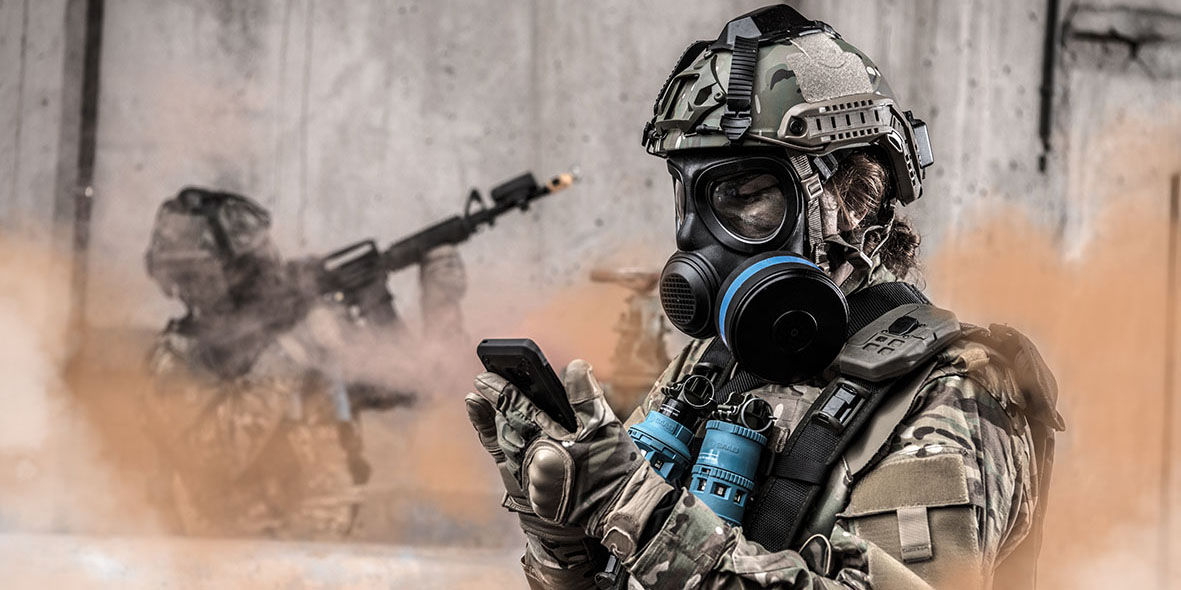
Image source: SAAB Training and Simulation
Modern warfare involving the infantry has shifted towards artillery and CBRN. The following 100 years of conflict will likely see weapons of mass destruction (WMD) playing centre stage. Military units must continue adapting to this threat and train for CBRN usage in a wide range of military operations.
At the turn of the century, CBRN training frequently involved belatedly reacting to chemical or radiological events rather than proactively facing threats. However, today, in any conflict, many militaries across the globe have the capability to employ multiple mission variables—including CBRN—to achieve their goals, which could include isolating specific units, occupying key territory, and introducing an element of complexity to the battlefield.
A CBRN event is intended to create an advantage by challenging and significantly degrading the opposing military’s capability to react. Combined Arms Training exercises that include a CBRN component attempt to prepare soldiers for a chemical or radiological event and minimise any impact or tactical advantage that could be gained by opponents as a result.
Combined Arms Training
Combined Arms Training (or collective training as it is sometimes referred to) is an approach to warfare that integrates different branches of the military; the objective is for each discipline to support and complement the other.
This approach to warfare influences how the military prepares itself to engage an enemy in Large Scale and Urban Combat Operations, and both offensive and defensive training involves identifying and validating gaps, requirements and confirming operational readiness.
A recent training exercise carried out by the Russian military is an excellent example of how the armed forces can take a combined arms approach. The exercise was said to contain tactical tasks between motorised rifle, tank, artillery battalions, and attached specialised units. The attached specialised units included chemical, biological, radiological, and nuclear defence (CBRN), engineering, and electronic warfare units. It is clear from this action that the Russian military takes CBRN very seriously and sees the value of incorporating a CBRN element into a combined arms training exercise.
Locations of Russian Military Exercises – August 9 to September 15, 2021
Incorporating CBRN into Combined Arms Training Exercises
It is widely accepted that Combined Arms training is very important. Lieutenant General Rick Burr, Chief of the Australian Army, told The Cove, an online professional development network for the Australian Army, that:
“The demands of current and future battlefields, emerging technology, changing demographics, and the need to maintain a competitive advantage...have driven the Combined Arms Training Centre (CATC) to examine new ways of training the Army.”
However, including a CBRN component as part of the training exercise is not a widespread practice—and neither is it particularly popular. Consequently, Combined Arms training exercises often do not extend beyond soldiers practising donning their respirators, which of course omits the use of important Detection, Identification and Monitoring (DIM) equipment.
Dr Mudit Sharma Sharma, public health expert and former Commanding Officer at the Indian Air Force Institute of NBC Protection, says that conventional warfare is not likely in modern times; therefore, “the likelihood of use of non-conventional weapons becomes a practical reality”. Therefore, not practising for an event in which ‘non-conventional’ weapons are used as part of a Combined Arms training exercise is likely to be missing out on a central component of modern warfare.
Simulation training offers repeatability, controllability, the possibility for evaluation, and the chance to reduce costs. It is arguably the most effective and efficient way to train soldiers for a CBRN event.
Simulating a CBRN event in a Combined Arms training exercise
In a bid to address the challenges of providing realistic and safe CBRN training exercises, Argon Electronics collaborated with Swedish military defence solutions provider Saab AB. The two companies produced a concept demonstrator of Argons’ wide-area instrumented training system, the PlumeSIM Live CBRN training system, integrated with SAABs’ high-fidelity laser-based Gamer system. The result is a versatile integrated training tool that can incorporate the CBRN element into any combined arms training exercise.
This footage shows an approaching enemy Land Rover, which has been weaponised with a chemical weapon (simulated by the plume release located on top of the engine). The vehicle is then fired upon and immobilised by the soldiers. The Gamer system activates PlumeSIM, and, consequently, the soldier’s chemical detectors (Smiths Detection M4JCADs / LCD3.2e simulators) are activated. Aware of the threat, the soldiers don their respirators, preventing casualties.
This training exercise is an example of how the enhanced PlumeSIM interface provides CBRN instructors with the ability to devise highly realistic, flexible, and efficient exercise scenarios. Trainees reactions can be monitored and procedures improved to ameliorate responses. Additionally, the simulator offers a powerful After Action Review (AAR), which can be used to give trainees post-exercise feedback.
Exercise controllers can manage the precise nature of plumes or hotspots, they can stipulate the environmental conditions in which the exercise take place, and they can predetermine specific release characteristics such as duration and persistence.
Most importantly, the use of the Argon PlumeSIM and SAAB Gamer system presents zero safety risk to personnel, environment, or infrastructure.
Further possibilities for the PlumeSIM
The technology supports both portable and vehicle-based instruments (including reconnaissance vehicles and robots). Although the footage only showed usage with a chemical weapon, it can also be used in conjunction with a diverse range of radiological materials.
Getting in touch with Argon Electronics
If you require any additional information about integrating simulation-based technologies into a Combined Arms training exercise, please feel free to contact us. We would be delighted to advise you and provide you with a demonstration of how our systems work.





